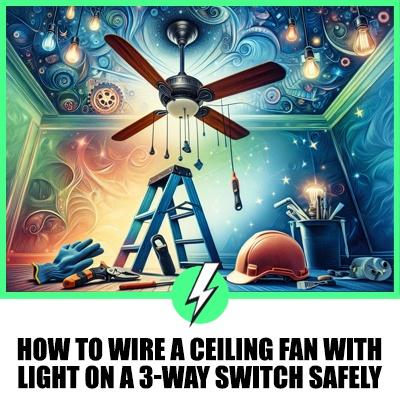How to Wire a Ceiling Fan with Light on a 3-Way Switch Safely
Wiring a ceiling fan with a light to a 3-way switch adds convenience and flexibility to any room, allowing you to control the fan and light from two different locations.
While it might seem complex, with a clear understanding and the right tools, you can undertake this project confidently.
Well, we’ll be going over:
- What are the essential steps to safely wire a ceiling fan with a light to a 3-way switch?
- How can you ensure that the wiring is done correctly and safely, following the basic principles of electrical wiring?
- What precautions should you take to avoid common pitfalls and ensure a successful installation?
Let’s dive in.

Contents
Understanding the Basics of Electrical Wiring
Before you dive into wiring a ceiling fan with a light to a 3-way switch, it’s essential to grasp some electrical wiring basics.
Safety first, always ensure the power is off at the breaker before starting any electrical project. Understanding how electricity flows is crucial. It moves from the power source, through the switch, and to the fixture.
In a 3-way switch setup, you’re dealing with three types of wires: hot, neutral, and ground wires.
You’ll also encounter two different switches controlling the same light or fan. This setup enables you to control the ceiling fan and light from two separate locations, perfect for rooms with multiple entrances.
Remember, reading and comprehending the wiring diagram that comes with your ceiling fan and switch is key. It’ll provide a visual representation of how everything needs to connect, ensuring you wire everything correctly and safely.
Tools and Materials Needed
Before diving into the task of wiring a ceiling fan with a light to a 3-way switch, it’s crucial you gather all the necessary tools and materials.
Being well-prepared not only makes the job smoother but also ensures safety and efficiency during the installation process.
First off, you’ll need a few basic hand tools:
- Screwdrivers (both Phillips and flat-head)
- Wire stripper
- Needle-nose pliers
- Voltage tester
Materials required for this task include:
- Ceiling fan with light kit
- 3-way switches (2)
- 14/3 or 12/3 electrical wire (depending on your current setup and load requirements)
- Wire nuts
- Electrical tape
- Wall plates for the switches
Ensure that the electrical wire gauge matches your ceiling fan’s power requirements. If unsure, consulting the manufacturer’s instructions or a professional electrician is advisable.
Properly assessing your needs before starting can save time and prevent unnecessary trips to the hardware store.
Wiring the Ceiling Fan with Light to the 3-Way Switch
Wiring your ceiling fan with a light to a 3-way switch allows you to control the fan and light from two different locations.
This setup is not only convenient but also enhances the functionality of your space. You’ll need to follow a specific sequence to ensure everything works seamlessly.
Firstly, turn off the power at the circuit breaker to ensure a safe working environment. Confirm the power is off with a voltage tester at both switch locations.
With the power off, you can start by connecting the fan’s and light’s ground wires to the ground wire in the ceiling box, typically green or bare copper.
Next, identify the wires. Ceiling fans with lights will have different wires for the fan motor and the light fixture, usually black for the fan, blue for the light, and white for the common neutral.
The 3-way switches will have a common terminal and two traveller terminals. Your job is to connect the fan’s black wire and the light’s blue wire to the ceiling box’s black wire, which leads to the switch’s common terminal.
Connect the red and black wires from the ceiling box to the traveller terminals on the first 3-way switch. Repeat this process for the second switch but ensure you’re connecting to the corresponding traveller wires.
The white neutral wires from the fan and light fixtures should connect to the white neutral wire in the ceiling box.
Finally, use wire nuts to secure all connections and apply electrical tape for added safety. Carefully mount the fan and switches, ensuring all wires are neatly tucked away before restoring the power to test your installation.
Remember, precise wire identification and connections are paramount for the system to function correctly.
Testing and Troubleshooting
After wiring your ceiling fan with a light to a 3-way switch, testing is crucial to ensure everything operates as expected.
Start by turning the power back on at the main circuit breaker. Then, operate the switches from both locations to check if the fan and light respond correctly.
If the fan or light does not function properly, turn the power off immediately and start troubleshooting.
First, verify all the wire connections are secure and correctly matched by color or function. It’s common for issues to arise from loose or wrongly connected wires.
Should the problem persist, inspect the switches to ensure they’re properly installed and functioning. Switch malfunctions can often be the culprit behind operational issues.
Remember, Safety First; if you’re unsure about any step, consulting with an electrician is always the best course of action.
Safety Precautions
Before you embark on wiring your ceiling fan with a light to a 3-way switch, prioritizing safety is paramount. Always turn off the power at the circuit breaker before beginning any electrical work.
It’s not just about preventing a possible shock; it’s about ensuring your safety throughout the installation process.
Wear protective gear such as insulated gloves and safety glasses. Electrical work can be unpredictable, and these precautions protect you from unexpected arcs or debris.
Verify the electrical box in your ceiling is rated for the weight and motion of a ceiling fan. Using a box not designed for this purpose can lead to structural failure and possible injury.
Lastly, be familiar with your local electrical codes. These regulations are in place for your safety and ensure that your installation is both safe and legal.
If there’s ever a moment of doubt or confusion, don’t hesitate to consult with or hire a professional electrician. Their expertise can help you navigate complex wiring challenges safely.
Conclusion
Wiring a ceiling fan with a light to a 3-way switch can be a rewarding DIY project, but it’s vital to prioritise your safety and compliance with local regulations.
By turning off the power, wearing the right protective gear, and ensuring your setup is up to code, you’re setting the stage for a successful installation.
Remember, if the task seems daunting or beyond your skill level, there’s no shame in calling in a professional. They can help you navigate the complexities, ensuring your fan operates safely and efficiently.
With these steps in mind, you’re well on your way to enjoying the comfort and convenience of your newly installed ceiling fan and light.





